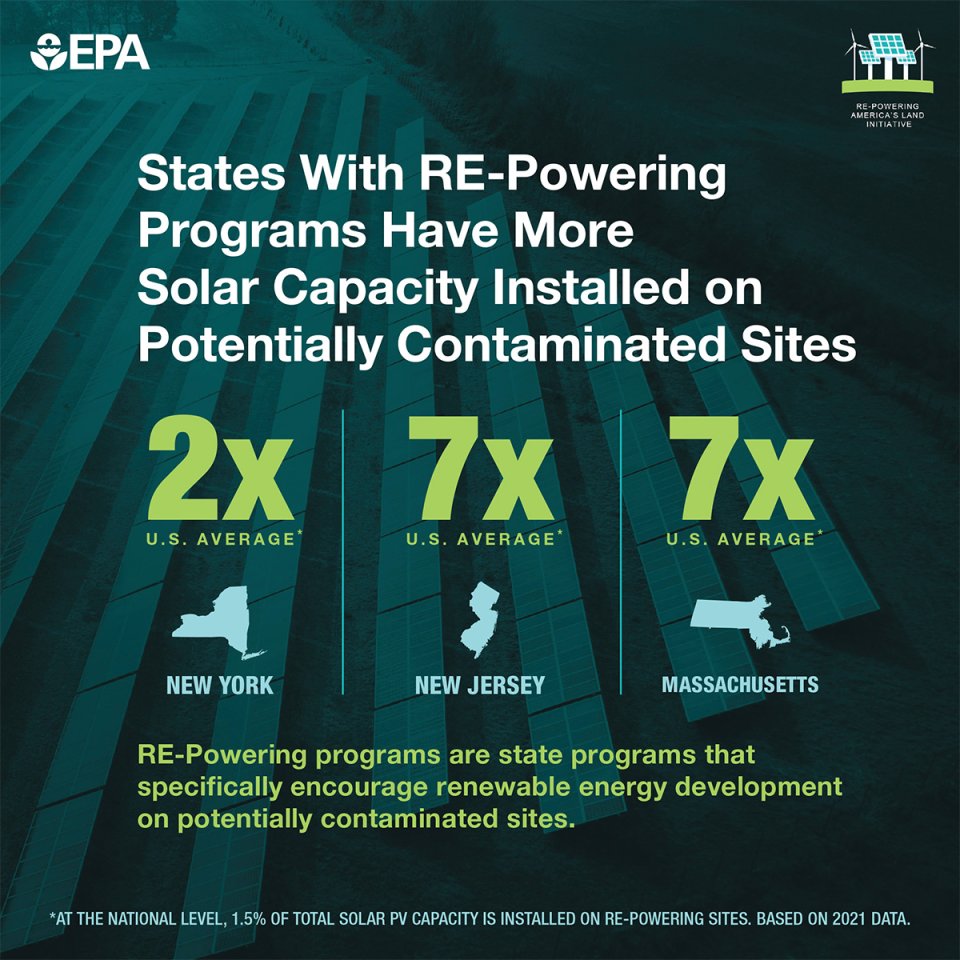RE-Powering America’s Land Initiative Webinars
EPA hosts webinars to help stakeholders explore development of renewable energy resources on formerly contaminated lands. The webinars highlight EPA resources; feature presentations by renewable energy and land redevelopment experts; and share examples of successful projects, programs and policies.
Check out previous webinars, recordings, slides and materials:
State and Federal Data in the RE-Powering Mapper 3.0
State and Federal Data in the RE-Powering Mapper 3.0
The webinar is a demonstration of the updated EPA RE-Powering Mapper. Learn how data included in the RE-Powering Mapper is critical to putting idle and underutilized land back to productive reuse. The mapper demonstration walks through how to identify contaminated lands that might be suitable for renewable energy development.
EPA's RE-Powering Mapper is an interactive web application that allows users to identify contaminated lands, landfills and mine sites for renewable energy development. Using renewable energy criteria developed in collaboration with the National Renewable Energy Laboratory (NREL), EPA has pre-screened over 190,000 sites for their renewable energy potential. As part of this effort, EPA collaborated with state agencies from California, Colorado, Connecticut, Florida, Hawaii, Illinois, Iowa, Maine, Maryland, Massachusetts, Minnesota, Missouri, New Jersey, New York, North Carolina, Oregon, Pennsylvania, Rhode Island, Texas, Virginia, West Virginia and Wisconsin.
Unlocking Brightfields Potential: State Programs to Encourage Renewable Energy Siting on Contaminated Lands - RE-Powering America's Land Initiative
The Unlocking Brightfields Potential webinar explores how state-based programs increase renewable energy projects on landfills, brownfields, mines, and other contaminated lands. It discusses common types of state programs, program impacts, steps to select, and design successful programs, and program implementation tips.

States with the most renewable project development on contaminated lands, landfills, and mine sites typically have fostered, designed, and implemented longstanding, state-specific programs targeted at underutilized lands.
The webinar features a panel with agency staff from three leading states who discuss how they have created and managed successful programs. These states continue to adapt programs to support environmental, land reuse, and economic policy goals in their jurisdictions to expand contaminated site reuse and steer renewable development away from greenfield sites and agricultural lands.
RE-Powering State Program Materials:
January 26, 2022 State Program Selection and Design Tips (pdf)
Power and Pollinators: Pollinator-Friendly Landscapes for Solar Facilities
Power and Pollinators: Pollinator-Friendly Landscapes for Solar Facilities
The Power and Pollinators webinar examines how planting for pollinators on RE-Powering sites benefits cleaning up contaminated sites while beautifying communities. Planting for pollinators can help protect caps, control runoff, and provide habitat for struggling pollinator communities.
The Power and Pollinators: Pollinator-Friendly Landscapes for Solar Facilities and Beyond webinar was hosted by: the Virginia Department of Conservation and Recreation, the Virginia Department of Environmental Quality, VHB, Fresh Energy and the US Environmental Protection Agency (EPA). The webinar explores the relationship between solar installations, contaminated lands and landfills, and pollinators.
Energy + Land = Resiliency: How Contaminated Lands Can Meet Critical Energy Needs
Energy + Land = Resiliency: How Contaminated Lands Can Meet Critical Energy Needs
The Energy Resiliency webinar examines how to use contaminated lands to create opportunities for a more resilient community. Renewable energy in combination with a distributed electricity grid can make communities more resilient. Benefits of this approach include protection against grid failure and isolation of specific facilities against widespread outages, including outages associated with natural disasters or other system stressors.
Energy + Land = Resiliency: How Contaminated Lands Can Meet Critical Energy Needs – This webinar was hosted by the US Environmental Protection Agency: Boulder County Office of Sustainability; Climate Action and Resilience; and the National Renewable Energy Lab (NREL).
